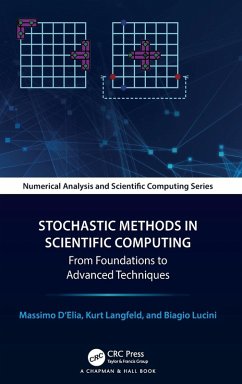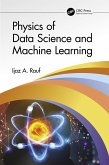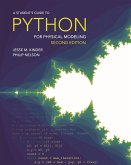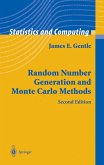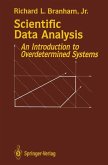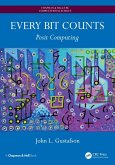Massimo D'Elia, Kurt Langfeld, Biagio Lucini
Stochastic Methods in Scientific Computing
From Foundations to Advanced Techniques
Massimo D'Elia, Kurt Langfeld, Biagio Lucini
Stochastic Methods in Scientific Computing
From Foundations to Advanced Techniques
- Gebundenes Buch
- Merkliste
- Auf die Merkliste
- Bewerten Bewerten
- Teilen
- Produkt teilen
- Produkterinnerung
- Produkterinnerung
This book introduces the reader to advanced concepts in stochastic modelling, rooted in an intuitive yet rigorous presentation of the underlying mathematical concepts. The reader will find valuable insights into topics ranging from Social Sciences and Particle Physics to modern-day Computer Science with Machine Learning and AI in focus.
Andere Kunden interessierten sich auch für
![Introduction to Python for Science and Engineering Introduction to Python for Science and Engineering]() David J PineIntroduction to Python for Science and Engineering173,99 €
David J PineIntroduction to Python for Science and Engineering173,99 €![Physics of Data Science and Machine Learning Physics of Data Science and Machine Learning]() Ijaz A RaufPhysics of Data Science and Machine Learning115,99 €
Ijaz A RaufPhysics of Data Science and Machine Learning115,99 €![A Student's Guide to Python for Physical Modeling A Student's Guide to Python for Physical Modeling]() Jesse M KinderA Student's Guide to Python for Physical Modeling91,99 €
Jesse M KinderA Student's Guide to Python for Physical Modeling91,99 €![Random Number Generation and Monte Carlo Methods Random Number Generation and Monte Carlo Methods]() James E. GentleRandom Number Generation and Monte Carlo Methods135,99 €
James E. GentleRandom Number Generation and Monte Carlo Methods135,99 €![Scientific Data Analysis Scientific Data Analysis]() Richard L. BranhamScientific Data Analysis39,99 €
Richard L. BranhamScientific Data Analysis39,99 €![High Performance Scientific And Engineering Computing High Performance Scientific And Engineering Computing]() Michael Breuer / Franz Durst / Christoph Zenger (eds.)High Performance Scientific And Engineering Computing77,99 €
Michael Breuer / Franz Durst / Christoph Zenger (eds.)High Performance Scientific And Engineering Computing77,99 €![Every Bit Counts Every Bit Counts]() John L GustafsonEvery Bit Counts144,99 €
John L GustafsonEvery Bit Counts144,99 €-
-
-
This book introduces the reader to advanced concepts in stochastic modelling, rooted in an intuitive yet rigorous presentation of the underlying mathematical concepts. The reader will find valuable insights into topics ranging from Social Sciences and Particle Physics to modern-day Computer Science with Machine Learning and AI in focus.
Produktdetails
- Produktdetails
- Verlag: CRC Press
- Seitenzahl: 382
- Erscheinungstermin: 11. Juni 2024
- Englisch
- Abmessung: 234mm x 156mm x 22mm
- Gewicht: 735g
- ISBN-13: 9781498796330
- ISBN-10: 1498796338
- Artikelnr.: 63364522
- Herstellerkennzeichnung
- Libri GmbH
- Europaallee 1
- 36244 Bad Hersfeld
- gpsr@libri.de
- Verlag: CRC Press
- Seitenzahl: 382
- Erscheinungstermin: 11. Juni 2024
- Englisch
- Abmessung: 234mm x 156mm x 22mm
- Gewicht: 735g
- ISBN-13: 9781498796330
- ISBN-10: 1498796338
- Artikelnr.: 63364522
- Herstellerkennzeichnung
- Libri GmbH
- Europaallee 1
- 36244 Bad Hersfeld
- gpsr@libri.de
Massimo D'Elia is Professor of Theoretical Physics at the Physics Department of the University of Pisa. Alumnus of the Scuola Normale Superiore in Pisa, he got his PhD in Physics from Pisa University in 1998. He has been Postdoctoral Fellow at the University of Cyprus and at ETH, Zurich, and Assistant Professor at the Physics Department of the University of Genoa. He is an expert in Lattice Gauge Theories and their implementation on HPC infrastructures, with interests also in Quantum Computing and numerical approaches to Quantum Gravity. He has obtained various achievements, especially in the study of the Phase Diagram of strong interactions. He has served as a reviewer for major scientific journals and funding agencies. He is author of two textbooks and more than 200 papers. Kurt Langfeld is Professor of Theoretical Physics and Head of School of Mathematics at the University of Leeds, England. His work in numerical methods for simulating Quantum Field Theories and Particle Physics is widely respected, with over 180 articles published in international journals. In 1991, he was awarded a PhD in Theoretical Physics from Technical University of Munich. He went on to serve as Researcher and Lecturer at the University of T¿ubingen, Germany from 1991 to 2006; during this time he also enjoyed research visits to CEA, Saclay (Paris) and KIAS (Seoul). In 1999, he achieved the highly esteemed Venia Legendi award at the University of Tubingen. 2005 saw him become Professor for Theoretical Physics at the University of Tubingen, before moving on to Plymouth Univeristy as part of their Particle Physics group in 2006. April 2012 saw him assume full Professorship for Theoretical Physics at Plymouth and 2016 saw him become Professor and Head of Department of Mathematical Sciences at the University of Liverpool. In 2020, he took up his current role as Head of School of Mathematics at the University of Leeds. He has dedicated himself to giving back to the community; he has been an active reviewer for the Engineering and Physical Sciences Research Council (EPSRC), Austrian council FWF, Swiss National Supercomputer Center (CSCS). He is a member of the Parliament Scientific Committee, devoted trustee of the University of Liverpool Maths School (ULMaS) and part of the Steering Group opening an University sponsored Mathematics specialist 6th form in Leeds. Biagio Lucini is a Fellow of the Learned Society of Wales and a Professor of Mathematics at Swansea University. He was awarded a Ph.D. in Theoretical Particle Physics by Scuola Normale (Pisa, Italy) in 2000. Before joining Swansea University in 2005, he was a Postdoctoral Fellow at the Rudolf Peierls Centre for Theoretical Physics (Oxford University, UK) from 2000 to 2003 and at the Theoretical Physics Institute of ETH (Zurich, Switzerland) from 2003 to 2005. Fellowship and awards he has received include a Royal Society Wolfson Merit Award (2017-2022) and a Leverhulme Research Fellowship (2020-2022). His research activity is centred around Monte Carlo calculations in Statistical Mechanics and Particle Physics. In particular, his interests are in Phase Transitions and Critical Phenomena, including machine learning approaches and efficient algorithms for simulations near criticality using High Performance Computing architectures. To date, his scientific contributions have resulted in over 180 research papers.
1. Random Numbers. 1.1. Random numbers and probability distribution. 1.2.
Central limit theorem. 1.3. Beyond the Normal distribution. 1.4. Exercises.
2. Random walks. 2.1. Random walk as a Markov process. 2.2. Random walks in
1 and 2 dimensions. 2.3. Levy flight. 2.4. Random walks with potentials.
2.5. Exercises. 3. Monte Carlo methods. 3.1. Objectives and concepts. 3.2.
Monte-Carlo integration. 3.3. Markov Chain Monte-Carlo. 3.4. Advanced Error
Analysis Techniques. 3.5. Error estimate in the presence of
autocorrelation. 3.6. Error estimate for non-trivial estimators: The
Jackknife, and the Bootstrap. 3.7. Biased Estimators. 3.8. Exercises. 4.
Statistical models. 4.1. An introduction to thermodynamics. 4.2. From
thermodynamics to statistical mechanics. 4.3. Phase transitions. 4.4. The
Ising model. 4.5. An overview of other models. 4.6. Exercises. 5. Advanced
Monte-Carlo simulation techniques. 5.1. Hamiltonian (Hybrid) Monte-Carlo
(HMC) simulations. 5.2. Non-local Monte-Carlo update. 5.3. Micro-canonical
simulations. 5.4. Flat histogram methods. 5.5. The Linear Logarithmic
Relaxation (LLR) method. 5.6. Exercises. 6. From Statistical Systems to
Quantum Field Theory. 6.1. Invitation: The O(2) model. 6.2. The Bridge to
QFT: the Feynman path-integral. 6.3. Gauge Theories. 6.4. Adding fermion
fields. 6.5. Exercises. 7. Current challenges in Monte-Carlo Simulations.
7.1. Sign and overlap problems. 7.2. Introduction to overlap problems. 7.3.
Estimating probability density functions. 8. Data Analytics and Statistical
Systems. 8.1. Model regression - L2 norm. 8.2. Gaussian Process. 8.3.
Machine learning with graphs. 8.4. Emulation of statistical systems with
Machine Learning. 8.5. Categorisation in statistical physics: Naive Bayes.
8.6. Machine learning classification of phase transitions.
Central limit theorem. 1.3. Beyond the Normal distribution. 1.4. Exercises.
2. Random walks. 2.1. Random walk as a Markov process. 2.2. Random walks in
1 and 2 dimensions. 2.3. Levy flight. 2.4. Random walks with potentials.
2.5. Exercises. 3. Monte Carlo methods. 3.1. Objectives and concepts. 3.2.
Monte-Carlo integration. 3.3. Markov Chain Monte-Carlo. 3.4. Advanced Error
Analysis Techniques. 3.5. Error estimate in the presence of
autocorrelation. 3.6. Error estimate for non-trivial estimators: The
Jackknife, and the Bootstrap. 3.7. Biased Estimators. 3.8. Exercises. 4.
Statistical models. 4.1. An introduction to thermodynamics. 4.2. From
thermodynamics to statistical mechanics. 4.3. Phase transitions. 4.4. The
Ising model. 4.5. An overview of other models. 4.6. Exercises. 5. Advanced
Monte-Carlo simulation techniques. 5.1. Hamiltonian (Hybrid) Monte-Carlo
(HMC) simulations. 5.2. Non-local Monte-Carlo update. 5.3. Micro-canonical
simulations. 5.4. Flat histogram methods. 5.5. The Linear Logarithmic
Relaxation (LLR) method. 5.6. Exercises. 6. From Statistical Systems to
Quantum Field Theory. 6.1. Invitation: The O(2) model. 6.2. The Bridge to
QFT: the Feynman path-integral. 6.3. Gauge Theories. 6.4. Adding fermion
fields. 6.5. Exercises. 7. Current challenges in Monte-Carlo Simulations.
7.1. Sign and overlap problems. 7.2. Introduction to overlap problems. 7.3.
Estimating probability density functions. 8. Data Analytics and Statistical
Systems. 8.1. Model regression - L2 norm. 8.2. Gaussian Process. 8.3.
Machine learning with graphs. 8.4. Emulation of statistical systems with
Machine Learning. 8.5. Categorisation in statistical physics: Naive Bayes.
8.6. Machine learning classification of phase transitions.
1. Random Numbers. 1.1. Random numbers and probability distribution. 1.2.
Central limit theorem. 1.3. Beyond the Normal distribution. 1.4. Exercises.
2. Random walks. 2.1. Random walk as a Markov process. 2.2. Random walks in
1 and 2 dimensions. 2.3. Levy flight. 2.4. Random walks with potentials.
2.5. Exercises. 3. Monte Carlo methods. 3.1. Objectives and concepts. 3.2.
Monte-Carlo integration. 3.3. Markov Chain Monte-Carlo. 3.4. Advanced Error
Analysis Techniques. 3.5. Error estimate in the presence of
autocorrelation. 3.6. Error estimate for non-trivial estimators: The
Jackknife, and the Bootstrap. 3.7. Biased Estimators. 3.8. Exercises. 4.
Statistical models. 4.1. An introduction to thermodynamics. 4.2. From
thermodynamics to statistical mechanics. 4.3. Phase transitions. 4.4. The
Ising model. 4.5. An overview of other models. 4.6. Exercises. 5. Advanced
Monte-Carlo simulation techniques. 5.1. Hamiltonian (Hybrid) Monte-Carlo
(HMC) simulations. 5.2. Non-local Monte-Carlo update. 5.3. Micro-canonical
simulations. 5.4. Flat histogram methods. 5.5. The Linear Logarithmic
Relaxation (LLR) method. 5.6. Exercises. 6. From Statistical Systems to
Quantum Field Theory. 6.1. Invitation: The O(2) model. 6.2. The Bridge to
QFT: the Feynman path-integral. 6.3. Gauge Theories. 6.4. Adding fermion
fields. 6.5. Exercises. 7. Current challenges in Monte-Carlo Simulations.
7.1. Sign and overlap problems. 7.2. Introduction to overlap problems. 7.3.
Estimating probability density functions. 8. Data Analytics and Statistical
Systems. 8.1. Model regression - L2 norm. 8.2. Gaussian Process. 8.3.
Machine learning with graphs. 8.4. Emulation of statistical systems with
Machine Learning. 8.5. Categorisation in statistical physics: Naive Bayes.
8.6. Machine learning classification of phase transitions.
Central limit theorem. 1.3. Beyond the Normal distribution. 1.4. Exercises.
2. Random walks. 2.1. Random walk as a Markov process. 2.2. Random walks in
1 and 2 dimensions. 2.3. Levy flight. 2.4. Random walks with potentials.
2.5. Exercises. 3. Monte Carlo methods. 3.1. Objectives and concepts. 3.2.
Monte-Carlo integration. 3.3. Markov Chain Monte-Carlo. 3.4. Advanced Error
Analysis Techniques. 3.5. Error estimate in the presence of
autocorrelation. 3.6. Error estimate for non-trivial estimators: The
Jackknife, and the Bootstrap. 3.7. Biased Estimators. 3.8. Exercises. 4.
Statistical models. 4.1. An introduction to thermodynamics. 4.2. From
thermodynamics to statistical mechanics. 4.3. Phase transitions. 4.4. The
Ising model. 4.5. An overview of other models. 4.6. Exercises. 5. Advanced
Monte-Carlo simulation techniques. 5.1. Hamiltonian (Hybrid) Monte-Carlo
(HMC) simulations. 5.2. Non-local Monte-Carlo update. 5.3. Micro-canonical
simulations. 5.4. Flat histogram methods. 5.5. The Linear Logarithmic
Relaxation (LLR) method. 5.6. Exercises. 6. From Statistical Systems to
Quantum Field Theory. 6.1. Invitation: The O(2) model. 6.2. The Bridge to
QFT: the Feynman path-integral. 6.3. Gauge Theories. 6.4. Adding fermion
fields. 6.5. Exercises. 7. Current challenges in Monte-Carlo Simulations.
7.1. Sign and overlap problems. 7.2. Introduction to overlap problems. 7.3.
Estimating probability density functions. 8. Data Analytics and Statistical
Systems. 8.1. Model regression - L2 norm. 8.2. Gaussian Process. 8.3.
Machine learning with graphs. 8.4. Emulation of statistical systems with
Machine Learning. 8.5. Categorisation in statistical physics: Naive Bayes.
8.6. Machine learning classification of phase transitions.

